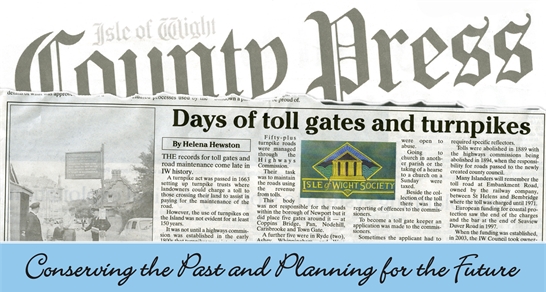February 2017
Turnpikes and Tolls
The records for toll gates and road maintenance comes late in Isle of Wight history.
A Turnpike Act was passed in 1663 setting up Turnpike Trusts where landowners could charge a toll to those crossing their land to assist in paying for the maintenance of the road. However, the use of Turnpikes on the Island was not evident for at least 150 years. It was not until a Highways Commission was established in the early 1800s that Turnpikes were introduced.
The first Turnpike roads were a single bar across the road with a Toll-bar cottage of wood or wattle to one side. One was located at the junction of Wilmingham Road and the “Middle Road” near Freshwater. Later the bar was replaced with a revolving gate with spikes on the top. Hence the name Turnpikes.
Fifty plus turnpike roads were managed through the Highways Commission. Their task was to maintain the roads using the revenue from tolls. This body was not responsible for the roads within the Borough of Newport but they did place five gates around it - at Coppins Bridge, Pan, Nodehill, Carisbrooke and Town Gate. A further five were in Ryde (2), Ashey, Whippingham, and West Cowes with 40plus elsewhere. Toll collection began in 1814 and a scale of charges covered the movement of livestock, materials, pedestrians and public or private transport. The gate on Hampstead Road was for the movement of salt prepared on the coast at Hamstead Grange. There was a complex set of conditions and responsibilities and these were open to abuse. Going to church in another parish or the taking of a hearse to a church on a Sunday were taxed. Beside the collection of the toll there was the reporting of offences to the Commissioners.
To become a toll gate keeper an application was made to the Commissioners. Sometimes the applicant had to put up surety. The post was weekly paid and the now stone or brick cottages were rent free occupying 20 sq ft overall even though the design was often octagonal. In 1816 tenders were issued for the maintenance of the buildings and for lamps. Buildings needed glazing, repairs and whitewashing and the lamps required specific reflectors.
Tolls were abolished in 1889 with the Highways Commissions being abolished in 1894 when the responsibility for roads passed to the newly created County Council.
Many Islanders will remember the toll road at Embankment Road, owned by the railway company,
between St Helens and Bembridge where the toll was charged until 1971.
European funding for coastal protection saw the end of the charges and the bar at the end of Seaview Duver Road in 1997. When the funding was established, in 2003, the Isle of Wight Council took ownership of the road and seawall for £1.
Until tarmac was introduced after the First World War the roads were just dirt and gravel tracks; dusty in summer and muddy and potholed in winter.
The underlying geology affects the surface of the roads, as it still does today as Island Roads, the Island Council and Island residents are well aware.
[Go Back]

